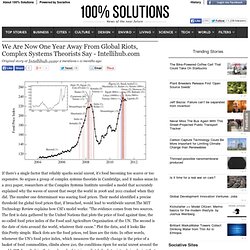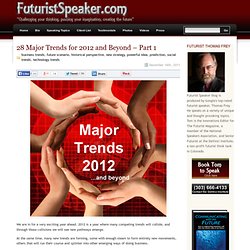

Faire ensemble 2020. We Are Now One Year Away From Global Riots, Complex Systems Theorists Say - Intellihub.com. If there’s a single factor that reliably sparks social unrest, it’s food becoming too scarce or too expensive.

So argues a group of complex systems theorists in Cambridge, and it makes sense.In a 2011 paper, researchers at the Complex Systems Institute unveiled a model that accurately explained why the waves of unrest that swept the world in 2008 and 2011 crashed when they did. The number one determinant was soaring food prices. Their model identified a precise threshold for global food prices that, if breached, would lead to worldwide unrest.The MIT Technology Review explains how CSI’s model works: “The evidence comes from two sources. The first is data gathered by the United Nations that plots the price of food against time, the so-called food price index of the Food and Agriculture Organisation of the UN. The second is the date of riots around the world, whatever their cause.” Trendwatching.com's South & Central America Trend Report 2013. Grain_a_moudre. Les tendances 2008 de 'architecture de commerce. Jean-Claude Prinz (Akdv), un des pionniers du design de commerce, Enseigne d’Or 2007, designer partage avec les lecteurs d’Admirable Design ses dernières obeservations sur nouvelles les tendances du secteur.

Ecoutons le maître... Un classement des tendances par style de vie On entend par style une référence culturelle. Sa pertinence et son originalité dans l’époque provoquent sa reconnaissance et son inscription dans l’histoire C’est la notion de leader d’opinion, hier un roi : LouisXIV, Louis XV, Napoléon, ...aujourd’hui une personnalité ( signatures, marques), un designer... Aujourd’hui, nous naviguons dans des traditions insolites, contemporaines, classiques, esthétiques, porteuses de valeurs émotionnelles. Future Tech. Foresight Into Insight Into Action. Houston Future’s In the Year 2050. The personal blog of Futurist Thomas Frey » Blog Archive » 28 Major Trends for 2012 and Beyond – Part 1. We are in for a very exciting year ahead. 2012 is a year where many competing trends will collide, and through those collisions we will see new pathways emerge.

At the same time, many new trends are forming, some with enough steam to form entirely new movements, others that will run their course and splinter into other emerging ways of doing business. The “new normal” is quickly becoming the “nothing normal,” and our daily routines, the things we use to maintain our own sanity, will need to morph and change if we hope to stay competitive in the emerging job market and even stay current in our own social circles. With this in mine, I’d like to take you on a journey into some of the trends I’ll be watching in 2012 as the tectonic plates of change inch their way into new positions.
Here is the first half of the 28 major trends to watch in 2012 and beyond. 1.) Some of the major expenses involved in traditional retail have been maintaining inventories and shelf space. 2.) 3.) 4.) 5.) 6.) Susan Greenfield on the Internet and ‘Mind Change’ What's Next - Who is. What’s Next is published by Richard Watson, a writer, speaker and scenario thinker that helps organisations to think further ahead.

As well as being the founder of What’s Next, Richard is co-founder of Futures House Europe (a specialist scenario planning agency) and is the author of four best selling books about the future, including Future Files (sixteen worldwide editions). Clients Richard has worked with, amongst others, Cambridge University, Coca-Cola, General Electric, IBM, Ikea, Imperial College, London Business School, McDonald’s, McKinsey & Company, Ministry of Defence, RAND, Samsung and Shell.
Subject matter expertise includes global trends, scenario planning, innovation and creativity. Speaking View a list of Richard’s previous talks. Credits Credits for this website also belong to Matt Doyle (web development) and Corrina Fox (additional research & writing). Further reading To view selected articles by Richard Watson please follow the links below: Why Smart Companies Do Dumb Things.